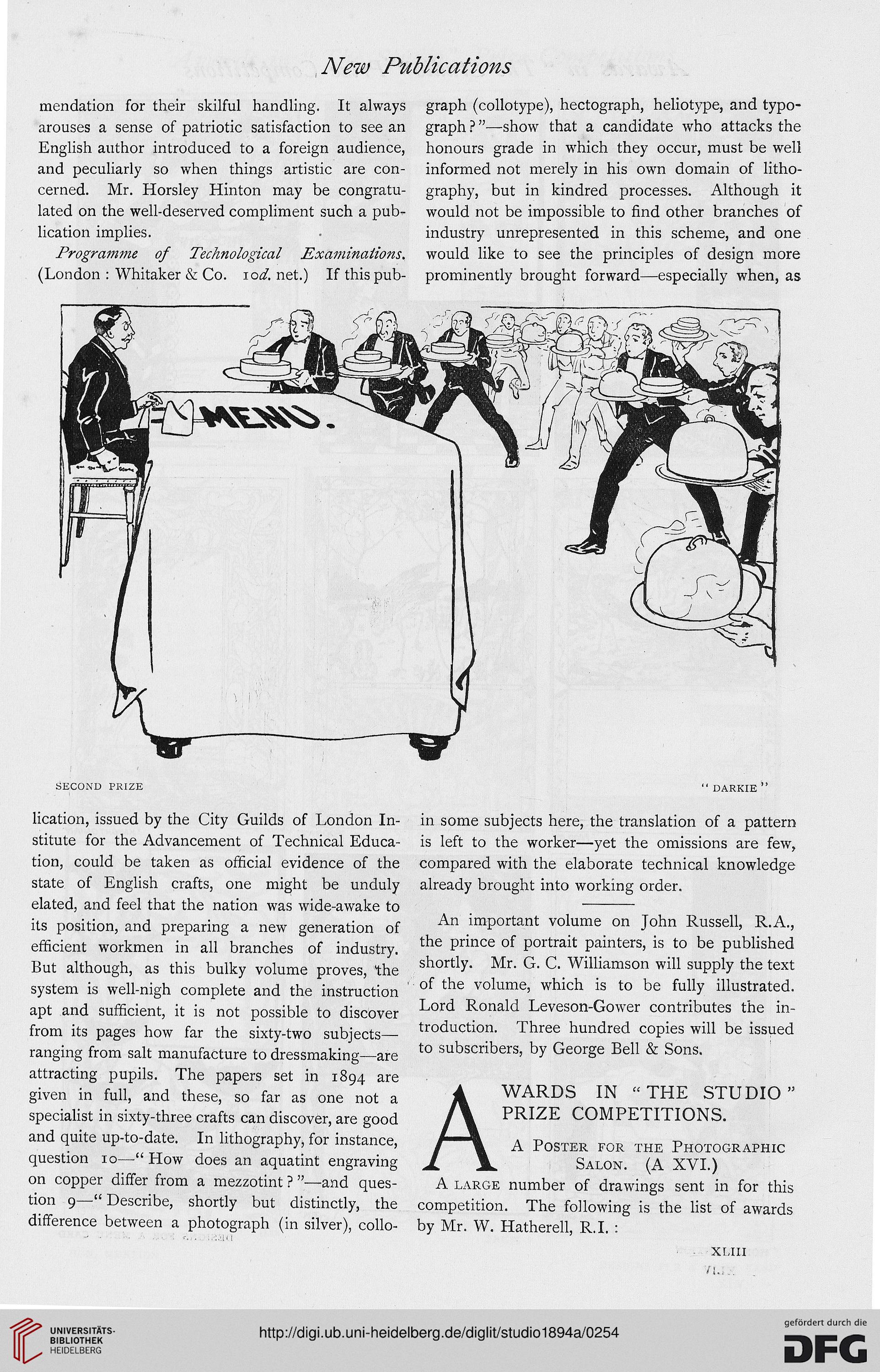New Publications
mendation for their skilful handling. It always graph (collotype), hectograph, heliotype, and typo-
arouses a sense of patriotic satisfaction to see an graph ? "—show that a candidate who attacks the
English author introduced to a foreign audience, honours grade in which they occur, must be well
and peculiarly so when things artistic are con- informed not merely in his own domain of litho-
cerned. Mr. Horsley Hinton may be congratu- graphy, but in kindred processes. Although it
lated on the well-deserved compliment such a pub- would not be impossible to find other branches of
lication implies. • industry unrepresented in this scheme, and one
Programme of Technological Examinations, would like to see the principles of design more
(London : Whitaker & Co. \od. net.) If this pub- prominently brought forward—especially when, as
SECOND PRIZE " DARKIE "
lication, issued by the City Guilds of London In- in some subjects here, the translation of a pattern
stitute for the Advancement of Technical Educa- is left to the worker—yet the omissions are few,
tion, could be taken as official evidence of the compared with the elaborate technical knowledge
state of English crafts, one might be unduly already brought into working order,
elated, and feel that the nation was wide-awake to
its position, and preparing a new generation of An imPortant volume on John RusselL R-A-
efficient workmen in all branches of industry. the Prmce of Portralt Palnters, is to be published
But although, as this bulky volume proves, the shortly- Mr" G" Q Wllllams°n will supply the text
system is well-nigh complete and the instruction of the volume' whlch 13 t0 be ful1? lllustrated.
apt and sufficient, it is not possible to discover Lord Ronald Leveson-Gower contributes the in-
from its pages how far the sixty-two subjects- troductlon- Three hundred copies will be issued
ranging from salt manufacture to dressmaking-are t0 subscribers. bY George Bell & Sons,
attracting pupils. The papers set in 1894 are
given in full, and these, so far as one not a A WARDS IN "THE STUDIO"
specialist in sixty-three crafts can discover, are good f\ PRIZE COMPETITIONS.
and quite up-to-date. In lithography, for instance, A-\ A p0ster for the Photographic
question 10—" How does an aquatint engraving j[ X. Salon. (A XVI.)
on copper differ from a mezzotint ? "—and ques- A large number of drawings sent in for this
tion 9—" Describe, shortly but distinctly, the competition. The following is the list of awards
difference between a photograph (in silver), collo- by Mr. W. Hatherell, R.I. :
xr.m
mendation for their skilful handling. It always graph (collotype), hectograph, heliotype, and typo-
arouses a sense of patriotic satisfaction to see an graph ? "—show that a candidate who attacks the
English author introduced to a foreign audience, honours grade in which they occur, must be well
and peculiarly so when things artistic are con- informed not merely in his own domain of litho-
cerned. Mr. Horsley Hinton may be congratu- graphy, but in kindred processes. Although it
lated on the well-deserved compliment such a pub- would not be impossible to find other branches of
lication implies. • industry unrepresented in this scheme, and one
Programme of Technological Examinations, would like to see the principles of design more
(London : Whitaker & Co. \od. net.) If this pub- prominently brought forward—especially when, as
SECOND PRIZE " DARKIE "
lication, issued by the City Guilds of London In- in some subjects here, the translation of a pattern
stitute for the Advancement of Technical Educa- is left to the worker—yet the omissions are few,
tion, could be taken as official evidence of the compared with the elaborate technical knowledge
state of English crafts, one might be unduly already brought into working order,
elated, and feel that the nation was wide-awake to
its position, and preparing a new generation of An imPortant volume on John RusselL R-A-
efficient workmen in all branches of industry. the Prmce of Portralt Palnters, is to be published
But although, as this bulky volume proves, the shortly- Mr" G" Q Wllllams°n will supply the text
system is well-nigh complete and the instruction of the volume' whlch 13 t0 be ful1? lllustrated.
apt and sufficient, it is not possible to discover Lord Ronald Leveson-Gower contributes the in-
from its pages how far the sixty-two subjects- troductlon- Three hundred copies will be issued
ranging from salt manufacture to dressmaking-are t0 subscribers. bY George Bell & Sons,
attracting pupils. The papers set in 1894 are
given in full, and these, so far as one not a A WARDS IN "THE STUDIO"
specialist in sixty-three crafts can discover, are good f\ PRIZE COMPETITIONS.
and quite up-to-date. In lithography, for instance, A-\ A p0ster for the Photographic
question 10—" How does an aquatint engraving j[ X. Salon. (A XVI.)
on copper differ from a mezzotint ? "—and ques- A large number of drawings sent in for this
tion 9—" Describe, shortly but distinctly, the competition. The following is the list of awards
difference between a photograph (in silver), collo- by Mr. W. Hatherell, R.I. :
xr.m




